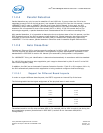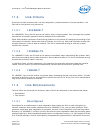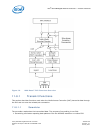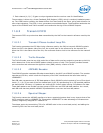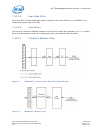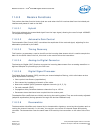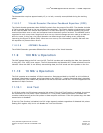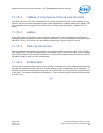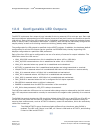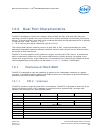
Receive Functions — Intel
®
82575EB Gigabit Ethernet Controller
324632-003 Intel
®
82575EB Gigabit Ethernet Controller
Revision: 2.1 Software Developer’s Manual and EEPROM Guide
January 2011 273
11.8.3 Receive Functions
This section describes function blocks that are used when the PHY receives data from the twisted pair
interface and passes it back to the MAC.
11.8.3.1 Hybrid
The hybrid subtracts the transmitted signal from the input signal, allowing the use of simple 100BASE-
TX compatible magnetics.
11.8.3.2 Automatic Gain Control
The Automatic Gain Control (AGC) normalizes the amplitude of the received signal, adjusting for the
attenuation produced by the cable.
11.8.3.3 Timing Recovery
This function re-generates a receive clock from the incoming data stream which is used to sample the
data. On the Slave side of the link, this clock is also used to drive the transmitter.
11.8.3.4 Analog-to-Digital Converter
The Analog-to-Digital (ADC) function converts the incoming data stream from an analog waveform to
digitized samples for processing by the DSP core.
11.8.3.5 Digital Signal Processor
The Digital Signal Processor (DSP) provides per-channel adaptive filtering, which eliminates various
signal impairments including:
• Inter-symbol interference (equalization).
• Echo caused by impedance mismatch of the cable.
• Near-end crosstalk (NEXT) between adjacent channels (A, B, C, D).
• Far-end crosstalk (FEXT)
• Propagation delay variations between channels of up to 120 ns.
• Extraneous tones that have been coupled into the receive path.
The adaptive filter coefficients are initially set during the training phase. They are continuously adjusted
(adaptive equalization) during operation through the decision-feedback loop.
11.8.3.6 Descrambler
The descrambler identifies each channel by its characteristic signature, removing the signature and re-
routing the channel internally. In this way, the receiver can correct for channel swaps and polarity
reversals. The descrambler uses the same base LFSR used by the transmitter on the other side of the
link.




